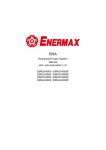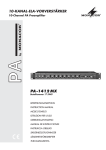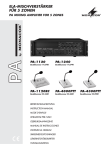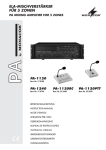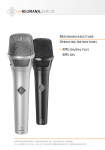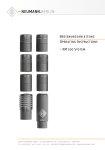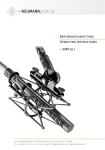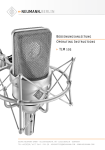Download Monacor EMG-650P
Transcript
EMG-650P Best.-Nr. 23.4330 D A CH ElektretSchwanenhalsmikrofon Bitte lesen Sie diese Bedienungsanleitung vor dem Betrieb gründlich durch und heben Sie sie für ein späteres Nachlesen auf. hoher Luftfeuchtigkeit und Hitze (zulässiger Einsatztemperaturbereich 0 – 40 °C). G Verwenden Sie für die Reinigung nur ein trockenes, weiches Tuch, niemals Chemikalien oder Wasser. G Wird das Mikrofon zweckentfremdet, falsch angeschlossen oder nicht fachgerecht repariert, kann keine Haftung für daraus resultierende Sach- oder Personenschäden und keine Garantie für das Mikrofon übernommen werden. 1 Einsatzmöglichkeiten Dieses Schwanenhalsmikrofon mit sehr guten Übertragungseigenschaften und hervorragender Sprachverständlichkeit ist speziell für Durchsagen, Vorträge oder sonstige Sprachübertragung geeignet, bei denen ein feststehendes Mikrofon benötigt wird. Es lässt sich direkt auf einen XLR-Mikrofonanschluss stecken oder zusammen mit dem Mikrofonfuß DMS-1 oder DMS-3 aus dem Sortiment von „img Stage Line“ als Tischmikrofon einsetzen. Zum Betrieb des Mikrofons ist eine Phantomspeisung (9 – 48 V) erforderlich. 2 Hinweise für den sicheren Gebrauch Das Mikrofon entspricht allen erforderlichen Richtlinien der EU und ist deshalb mit gekennzeichnet. G Setzen Sie das Mikrofon nur im Innenbereich ein und schützen Sie es vor Tropf- und Spritzwasser, GB Electret Gooseneck Microphone Please read these operating instructions carefully prior to operation and keep them for later use. 1 Applications This gooseneck microphone with very good transmission characteristics and excellent speech intelligibility is especially suitable for announcements, lectures, or other speech transmission requiring a stationary microphone. It can directly be placed on an XLR microphone connection. Alternatively, together with the microphone base DMS-1 or DMS-3 from the product range of “img Stage Line”, it can be used as a desk microphone. For operating the microphone, a phantom power (9 – 48 V) is required. 2 Safety Notes This microphone corresponds to all required directives of the EU and is therefore marked with . G The microphone is suitable for indoor use only. Protect it against dripping water and splash water, high F B CH Microphone électret col de cygne Veuillez lire la présente notice avec attention avant le fonctionnement et conservez-la pour pouvoir vous y reporter ultérieurement. Ce microphone col de cygne avec de très bonnes propriétés de transmission et excellente compréhension des discours est spécialement conçu pour des annonces, conférences ou autre transmission de discours, où un microphone fixe est nécessaire. Il peut se brancher directement sur une prise micro XLR ou peut également être utilisé comme microphone de table, combiné au pied micro DMS-1 ou DMS-3 de la gamme “img Stage Line”. Pour le fonctionnement du microphone, une alimentation fantôme (9 – 48 V) est nécessaire. 3 Inbetriebnahme 1) Den beiliegenden Wind- / Poppschutz (1) auf das Mikrofon setzen. 2) Das Mikrofon auf einen XLR-Mikrofonanschluss oder auf einen Mikrofonfuß stecken. Der Mikrofoneingang muss eine Phantomspeisung (9 – 48 V) bereitstellen. Ist dies nicht der Fall, das Mikrofon über ein separates Phantomspeisungsgerät (z. B. air humidity, and heat (admissible ambient temperature range 0 – 40 °C). G For cleaning only use a dry, soft cloth, by no means chemicals or water. G No guarantee claims for the microphone and no liability for any resulting personal damage or material damage will be accepted if it is used for other purposes than originally intended, if it is not correctly connected or not repaired in an expert way. If the microphone is to be put out of operation definitively, take it to a local recycling plant for a disposal which is not harmful to the environment. 3 Operation 1) Place the supplied windshield/pop protection (1) on the microphone. 2) Insert the microphone into an XLR microphone input or a microphone base. The microphone input must provide a phantom power (9 – 48 V). If not, connect the microphone via a separate phantom power supply unit (e. g. EMA-3, EMA-200, EMA-400 from the dʼeau, des éclaboussures, dʼune humidité élevée et de la chaleur (plage de température de fonctionnement autorisée : 0 – 40 °C). G Pour le nettoyer, utilisez uniquement un chiffon sec et doux, en aucun cas de produits chimiques ou dʼeau. G Nous déclinons toute responsabilité en cas de dommages matériels ou corporels résultants si le microphone est utilisé dans un but autre que celui pour lequel il a été conçu, sʼil nʼest pas correctement branché ou sʼil nʼest pas réparé par une personne habilitée ; en outre, la garantie deviendrait caduque. Lorsque le microphone est définitivement retiré du service, vous devez le déposer dans une usine de recyclage adaptée pour contribuer à son élimination non polluante. 3 Fonctionnement 2 Conseils dʼutilisation et de sécurité Le microphone répond à toutes les directives nécessaires de lʼUnion Européenne et porte donc le symbole . G Le microphone nʼest conçu que pour une utilisation en intérieur. Protégez-le de tout type de projections 1) Placez la bonnette de protection anti-pop et antivent (1) livrée sur le microphone. 2) Fixez le microphone sur une prise micro XLR ou sur un pied micro. Lʼentrée micro doit délivrer une alimentation fantôme (9 – 48 V). Si ce nʼest pas le cas, connectez le microphone via une alimentation 4 Technische Daten Mikrofontyp: . . . . . . . . . . . Richtcharakteristik: . . . . . Frequenzbereich:. . . . . . . Empfindlichkeit: . . . . . . . . Impedanz: . . . . . . . . . . . . max. Schalldruck: . . . . . . Stromversorgung: . . . . . . Elektret Niere 30 – 18 000 Hz 4,5 mV/Pa bei 1 kHz 180 Ω 130 dB Phantomspeisung 9 – 48 V Abmessungen:. . . . . . . . . ∅ 9/19 mm × 600 mm Anschluss: . . . . . . . . . . . . XLR, symmetrisch Änderungen vorbehalten. product range of “img Stage Line”) to the audio unit. As soon as the microphone is supplied with phantom power, the operating indication (3) lights up. 3) Adjust the microphone in an optimum way with the gooseneck (2). 4) To switch on the low cut filter (high pass 180 Hz, 12 dB/octave) [bass attenuation for compensating the proximity effect], set the switch (4) to position . 4 Specifications Microphone type: . . . . . . . Pick-up characteristic: . . . Frequency range:. . . . . . . Sensitivity: . . . . . . . . . . . . Impedance: . . . . . . . . . . . Max. SPL: . . . . . . . . . . . . Power supply: . . . . . . . . . electret cardioid 30 – 18 000 Hz 4.5 mV/Pa at 1 kHz 180 Ω 130 dB phantom power 9 – 48 V Dimensions: . . . . . . . . . . . ∅ 9/19 mm × 600 mm Connection: . . . . . . . . . . . XLR, balanced Subject to technical modification. fantôme distincte (par exemple EMA-3, EMA-200, EMA-400 de la gamme “img Stage Line”) à lʼappareil audio. Dès que lʼalimentation fantôme est présente au micro, le témoin de fonctionnement (3) brille. 3) Orientez le microphone de manière optimale avec le col de cygne (2). 4) Pour activer le filtre Low Cut (passe-haut 180 Hz, 12 dB/octave) [diminution des graves pour compenser lʼeffet de proximité], poussez le sélecteur (4) sur la position . 4 Caractéristiques techniques Type de micro : . . . . . . . . . électret Caractéristique : . . . . . . . . cardioïde Bande passante : . . . . . . . 30 – 18 000 Hz Sensibilité : . . . . . . . . . . . . 4,5 mV/Pa à 1 kHz Impédance : . . . . . . . . . . . . 180 Ω Pression sonore maximale : 130 dB Alimentation : . . . . . . . . . . . alimentation fantôme 9 – 48 V Dimensions : . . . . . . . . . . . ∅ 9/19 mm × 600 mm Connexion : . . . . . . . . . . . . XLR, symétrique Tout droit de modification reservé. 3 EMG-650P www.imgstageline.com 1 Possibilités dʼutilisation Soll das Mikrofon endgültig aus dem Betrieb genommen werden, übergeben Sie es zur umweltgerechten Entsorgung einem örtlichen Recyclingbetrieb. EMA-3, EMA-200, EMA-400 aus dem Sortiment von „img Stage Line“) an das Audiogerät anschließen. Sobald die Phantomspannung am Mikrofon anliegt, leuchtet die Betriebsanzeige (3). 3) Das Mikrofon mit dem Schwanenhals (2) optimal ausrichten. 4) Um das Low-Cut-Filter (Hochpass 180 Hz, 12 dB / Oktave) einzuschalten (Bassabsenkung zur Kompensation des Nahbesprechungseffekts), den Schalter (4) in die Position schieben. 1 2 ® 2 3 1 4 MONACOR INTERNATIONAL GmbH & Co. KG • Zum Falsch 36 • 28307 Bremen • Germany A-0531.99.02.05.2011 Copyright © by MONACOR INTERNATIONAL. All rights reserved. 1= 2 = Signal + 3 = Signal - EMG-650P Best.-Nr. 23.4330 I qua, da alta umidità dellʼaria e dal calore (temperatura dʼimpiego ammessa fra 0 e 40 °C). Microfono a elettrete a collo di cigno Vi preghiamo di leggere attentamente le presenti istruzioni prima della messa in funzione e di conservarle per un uso futuro. 1 Possibilità dʼimpiego Per la pulizia usare solo un panno morbido, asciutto; non impiegare in nessun caso prodotti chimici o acqua. G Nel caso dʼuso improprio, di collegamenti sbagliati, o di riparazione non a regola dʼarte del microfono, non si assume nessuna responsabilità per eventuali danni consequenziali a persone o a cose e non si assume nessuna garanzia per il microfono. Questo microfono a collo di cigno con ottime caratteristiche di trasmissione e con eccellente comprensione della lingua parlata è adatto in particolar modo per avvisi, conferenze o altre trasmissioni di lingua parlata dove è richiesto un microfono fisso. Può essere inserito direttamente su un contatto XLR per microfono oppure può essere impiegato, insieme alla base DMS-1 o DMS-3 del programma di “img Stage Line”, come microfono da tavolo. Per il funzionamento del microfono è richiesta lʼalimentazione phantom (9 – 48 V). 3 Messa in funzione 2 Avvertenze di sicurezza 1) Applicare la spugna antivento (1) in dotazione sul microfono. Tipo di microfono: . . . . . . Caratteristica direzionale: Gamma di frequenze: . . . Sensibilità: . . . . . . . . . . . . Impedenza: . . . . . . . . . . . Max. pressione sonora: . . Alimentazione: . . . . . . . . . Il microfono è conforme a tutte le direttive richieste dellʼUE e pertanto porta la sigla . G Usare il microfono solo allʼinterno di locali e proteggerlo dallʼacqua gocciolante e dagli spruzzi dʼac- 2) Inserire il microfono su un contatto XLR per microfono oppure su una base per microfono. Lʼingresso microfono deve disporre di unʼalimentazione phantom (9 – 48 V). Altrimenti collegare il Con riserva di modifiche tecniche. E Micrófono electret de cuello de cisne Por favor, lea estas instrucciones de funcionamiento cuidadosamente antes de usar el aparato y guárdelas para usos posteriores. 1 Usos Este micrófono de cuello de cisne de muy buenas características de transmisión y excelente inteligibilidad de palabra está especialmente indicado para anuncios, lecturas, u otra transmisión de habla que requiera un micrófono estático. Puede ser colocado directamente en una conexión de micrófono XLR. Alternativamente, junto con la base de micrófono DMS-1 o DMS-3 de la gama de productos de “img Stage Line”, puede ser usado como micrófono de mesa. Para utilizar el micrófono se requiere una alimentación phantom (9 – 48 V). 2 Notas para el uso seguro Este micrófono corresponde a todas las Directivas requeridas por la UE y por eso está marcado con . G El micrófono sólo está indicado para su uso en interior. Protéjalo contra proyecciones de agua, salpi- PL Mikrofon elektretowy na gęsiej szyi Prosimy o uważne przeczytanie poniższej instrukcji przed użyciem urządzenia, oraz o zachowanie tekstu do wglądu. 1 Zastosowanie Mikrofon na gęsiej szyi EMG-650P cechuje bardzo dobra charakterystyka transmisji oraz doskonała czytelność komunikatów słownych, dzięki czemu znajduje idealne zastosowanie przy zapowiedziach, wykładach, czy transmisji mowy innego rodzaju, dla których wymagany jest mikrofon stacjonarny. Mikrofon EMG-650P można podłączyć bezpośrednio do złączy mikrofonowych XLR, może on być również stosowany jako mikrofon pulpitowy, w połączeniu z mikrofonową podstawką stołową z oferty “img Stage Line”: DMS-1 lub DMS-3. Do poprawnego funkcjonowania mikrofon wymaga zasilania fantomowego (9 – 48 V). 2 Bezpieczeństwo użytkowania Urządzenie spełnia wymogi norm obowiązujących w Unii Europejskiej, jest zatem oznaczone symbolem . G Urządzenie przeznaczone jest do użytku jedynie wewnątrz pomieszczeń. Należy chronić je przed Se si desidera eliminare il microfono definitivamente, consegnarlo per lo smaltimento ad unʼistituzione locale per il riciclaggio. caduras, humedad elevada del aire y calor (temperatura de funcionamiento admisible 0 – 40 °C). G Para la limpieza use sólo un paño seco y suave; no use nunca productos químicos o agua. G No se aceptará ninguna reclamación para el micrófono ni responsabilidad alguna en caso de daños personales o materiales resultantes si el micrófono se usa para otros fines que los que se idearon originalmente, si no se conecta correctamente, o si no se repara de manera experta. Si el micrófono debe ser puesto fuera de funcionamiento definitivamente, llévelo a un centro de reciclaje local para su eliminación no contaminante para el medio ambiente. 3 Funcionamiento 1) Coloque la protección para el viento/anti-ruido (1) en el micrófono. 2) Inserte el micrófono en una entrada de micrófono XLR o una base de micrófono. La entrada de micrófono debe estar provista de una alimentación phantom (9 – 48 V). Si no, conecte el micrófono mediante una unidad de alimentación phantom se- bezpośrednim kontaktem z wodą, przed działaniem wilgoci oraz wysokiej temperatury (dopuszczalna temperatura otoczenia pracy to 0 – 40 ºC). G Do czyszczenia urządzenia należy używać suchej, miękkiej tkaniny; nie wolno stosować wody, ani chemicznych środków czyszczących. G Producent ani dostawca nie ponoszą odpowiedzialności za wynikłe szkody (uszkodzenie sprzętu lub obrażenia użytkownika), jeśli urządzenie było używane niezgodnie z przeznaczeniem, lub jeśli zostało nieprawidłowo podłączone, bądź poddane nieautoryzowanej naprawie. Jeśli urządzenie ma zostać ostatecznie wycofane z użycia, należy przekazać je do punktu utylizacji odpadów, aby uniknąć zanieczyszczenia środowiska. 3 Obsługa urządzenia 1) Należy nałożyć na mikrofon osłonę przeciwwietrzną (1). 2) Należy podłączyć mikrofon do wejścia mikrofonowego XLR lub do mikrofonowej podstawki stołowej. Na wejściu mikrofonowym musi być obecne napięcie fantomowe (9 – 48 V). W innym wypadku 4 Date tecnici elettrete cardioide 30 – 18 000 Hz 4,5 mV/Pa con 1 kHz 180 Ω 130 dB alimentazione phantom 9 – 48 V Dimensioni: . . . . . . . . . . . ∅ 9/19 mm × 600 mm Collegamento: . . . . . . . . . XLR, simmetrico parada (por ejemplo los EMA-3, EMA-200, EMA400 de la gama de de productos de “img Stage Line”) a la unidad de audio. Tan pronto como el micrófono es alimentado con alimentación phantom, el indicador de funcionamiento (3) se enciende. 3) Ajuste el micrófono de una manera óptima con el cuello de cisne (2). 4) Para encender el filtro low cut (high pass 180 Hz, 12 dB/octava) [atenuación baja para compensar el efecto de proximidad], coloque el interruptor (4) en la posición . 4 Características técnicas Tipo de micrófono: . . . . . . electret Característica: . . . . . . . . . cardioide Índice de frecuencia: . . . . 30 – 18 000 Hz Sensibilidad: . . . . . . . . . . 4,5 mV/Pa a 1 kHz Impedancia: . . . . . . . . . . . 180 Ω Presión máxima de sonido: 130 dB Alimentación: . . . . . . . . . . phantom 9 – 48 V Dimensiones: . . . . . . . . . . ∅ 9/19 mm × 600 mm Conexión:. . . . . . . . . . . . . XLR, simétrica Sujeto a modificaciones técnicas. należy podłączyć mikrofon do urządzenia audio przez zewnętrzny zasilacz fantomowy (np. z oferty firmy “img Stage Line”: EMA-3, EM-200, EMA400). Gdy mikrofon zostanie zasilony napięciem fantomowym, zapali się wskaźnik pracy urządzenia (3). 3) Należy wyregulować optymalne ustawienie mikrofonu za pomocą gęsiej szyi (2). 4) Aby włączyć filtr dolnozaporowy (górnoprzepust. 180 Hz, 12 dB / oktawę) [tłumienie niskich tonów dla kompensacji efektu bliskości], należy ustawić przełącznik (4) w pozycji . 4 Dane techniczne Typ mikrofonu: . . . . . . . . . Charakterystyka: . . . . . . . Pasmo przenoszenia: . . . Czułość: . . . . . . . . . . . . . . Impedancja: . . . . . . . . . . . Maks. SPL: . . . . . . . . . . . Zasilanie: . . . . . . . . . . . . . elektretowy kardioida 30 – 18 000 Hz 4,5 mV / Pa / 1 kHz 180 Ω 130 dB napięcie fantomowe 9 – 48 V Wymiary: . . . . . . . . . . . . . ∅ 9 / 19 mm × 600 mm Połączenie: . . . . . . . . . . . XLR, symetryczne Z zastrzeżeniem możliwości zmian. 3 EMG-650P www.imgstageline.com G microfono per mezzo di un alimentatore phantom separato (p. es. EMA-3, EMA-200, EMA-400 del programma “img Stage Line”) con lʼapparecchio audio. Non appena lʼalimentazione phantom è applicata, si accende la spia di funzionamento (3). 3) Orientare il microfono in modo ottimale con lʼaiuto del collo di cigno (2). 4) Per attivare il filtro Low-Cut (passa-alto 180 Hz, 12 dB/ottava) [abbassamento dei bassi per compensare lʼeffetto di prossimità], spostare lʼinterruttore (4) in posizione . 1 2 ® 2 3 1 4 MONACOR INTERNATIONAL GmbH & Co. KG • Zum Falsch 36 • 28307 Bremen • Germany A-0531.99.02.05.2011 Copyright © by MONACOR INTERNATIONAL. All rights reserved. 1= 2 = Signal + 3 = Signal -
This document in other languages
- français: Monacor EMG-650P
- español: Monacor EMG-650P
- Deutsch: Monacor EMG-650P
- polski: Monacor EMG-650P
- italiano: Monacor EMG-650P


